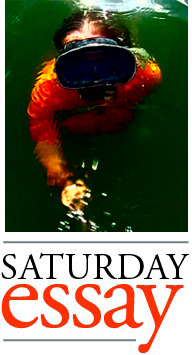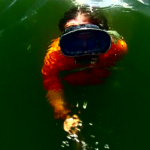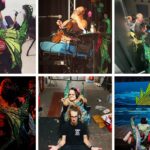The Wreck of the Ophelia
 Testimony of Mary Nettleton, from the 1898 Annual Report of the United States Life-Saving Service, chapter heading “Log of the Park Point, Duluth Station” (Lake Superior Maritime Museum archives):
Testimony of Mary Nettleton, from the 1898 Annual Report of the United States Life-Saving Service, chapter heading “Log of the Park Point, Duluth Station” (Lake Superior Maritime Museum archives):
I sailed for a year aboard a sunken ship, the wooden schooner-barge Ophelia. She sank on October 15, 1897 in Canadian waters, downbound for Duluth from Thunder Bay. I was finally rescued from the air pocket in her drowned saloon on October 12, 1898, having drifted 150 miles underwater to Duluth. The Ophelia arrived a year behind schedule, crossing the open border between the living and the dead. As to my miraculous survival, doctors and scientists set upon me to solve it. I have become an object of curiosity; fear also.
Sinking
I first encountered the Ophelia on a dock in Buffalo where I signed to be the ship’s cook. I was the only woman aboard. Originally a passenger ship, she couldn’t compete against steam power, so her owners ripped out the passenger suites in favor of three large cargo holds. The windjammer-turned-barge retained classy touches like her oversized saloon. We sailed three of the five Great Lakes in tow of the wooden steamer Harlow, who rode heavy before the gale that snapped the towline and drove us apart. The blow ripped away what rigging could be raised and then downed both our masts. But it wasn’t the mountainous seas that sank us. It was a spar snapped off the deck of the Harlow that staved a hole in our bow. The pumps couldn’t keep up.
Captain Tuttle launched the yawl boat, so the mate and our seven seamen could make the hundred-yard pull for shore. But it flipped as soon as it hit the water. The men drowned in their useless life vests; cork turned to powder long ago. I had refused one, laughing in the Captain’s face. He told me he was going down with the ship. I told him I was retreating below decks to await meeting Jesus.
That was the terrible moment she sank. Captain Tuttle washed overboard as the Ophelia fell away beneath his feet. She dove for the bottom and the wall of seawater slammed me back through the hatch and down the stairs, tumbling me through the corridor to the ship’s saloon. I washed up there as if on a beach, bruised, buffeted, and vomiting. I waited in the rising water as the ship groaned. The stage at the back of the room remained dry, and the kerosene lamps on its rear wall still burned as if unnaturally, tilting in our steepening descent. Instinct drove me to climb up the bolted chairs and tables toward the light. My woolen skirts heavy with water, I pulled myself to the stage piano and clung to it. I wondered if I would drown or be crushed. The pressure in my ears grew as the volume of the sea squeezed the vessel, as the glass in the saloon’s four portholes bowed in, approaching their absolute limit. I supposed my body would never be found, not that there was anyone particularly to come looking. I prayed to live but also for a quick death.
It dawned on me the ship was evening her keel. Water stopped rising in the saloon as the righting of the ship closed off the air’s escape routes. Only thigh-deep water remained, even though the Ophelia was completely submerged and still sinking. I felt it in my eardrums and the pit in my stomach. But I could also tell the current had her now. I no longer had to cling to the piano, so I stood on the stage and listened — she had quieted the worst of her protestations. I wasn’t sure how deep the water was here — 50 feet perhaps? I felt us touch bottom, and the jolt startled me — but the Ophelia retained just enough buoyancy to slip along the sand in the current. I kept waiting to die, for who ever heard of a shipwreck victim who hadn’t? But I kept not dying.
I knew that along the North Shore, the currents flow toward Duluth, and are generally upwelling. I hoped if the wreck kept on her weird course, she might wash up there, and then my body could be found at least.
But since I had time to wait, I collected myself. I put out all the lights but one and dimmed it to conserve kerosene and air. Surely there was no more than a few days to breathe in this drowned saloon. A slow suffocation seemed less terrible than drowning or being crushed. Among the flotsam in the room floated one of the ship’s thick rubber safety suits, which mitigated my danger of freezing to death. Reserved for water emergencies just such as this, the ship had only two. The crew had not had time to don them as first they tried to save the stricken vessel, then turned their attention to fleeing it. Sized for men, I was so cold I wanted to wear both of them one atop the other, doubling warmth at the expense of dexterity. To find the second one, I would have to leave the saloon and swim the lightless corridors.
Below
It took many days but I achieved this goal, from necessity learning to hold my breath for several minutes. I collected many items I would need for my survival including more kerosene. I made an alcohol lamp with a flint striker, cotton shoelaces, and a bottle of Grand Marnier Cordon Rouge. It put out a little heat and smelled like oranges. From the galley I rescued sides of salted ham and other foodstuffs, although much was ruined. And I discovered substantial air pockets in two of the ship’s three holds, half flooded. The aft hold below the saloon contained enough sacks of wheat to feed an army. In the hold amidships were stacked barrels of hydrogen peroxide, the latest in bleaching wood pulp. It was also half flooded. The completely flooded hold at the bow of the ship got stove in and contained barrels of salt, some damaged.
When I needed to restock food, I would slip into the water at the foot of the saloon, swim down the stairs, and surface in the air pocket in the wheat hold, or gruel room as I came to call it. Much of the grain began rotting and smelled awful. But the hold had two tiers and in the upper one the grain was still good. I would retrieve as much as I could carry, then prepare it in the saloon, ironically, by soaking it, using bowls from the adjacent galley. After a few days the grains fermented and became soft enough to chew. I ate them like a cold porridge with salt. Sometimes I used the mortar and pestle behind the bar to grind it to different consistencies for variety.
The Ophelia occasionally bobbed up, breaking the surface like a whale taking a breath and my ears popped. Her keel peeked out of the green water spilling from the deck before bobbing under again. Sometimes these breaks from underwater life lasted many hours. The deck strived to remain out of the water, choking down air while the pilot house stuck up like a dorsal fin. From its roof I attempted signaling other vessels, and fished while the ship’s air pockets refreshed like great lungs. Then she would start to sink again and I scrambled through the flooded passages to the saloon, its small stage the dryest corner of the ship.
I am told by the doctors and scientists who examined my case that the air pockets formed because, in addition to luck, she had been freshly caulked, sealed, and painted. And the steadily dissolving salt washing from the forward hold created an envelope of more-buoyant saltwater around the vessel, keeping her from settling on the lake floor. She skipped across the sand. Often the bottom would drop away for long stretches, but I do not believe we ever sailed much deeper than 10 fathoms. I used a lot of guesswork to arrive at that figure but after a while the body of the ship transmitted sensations to me, a sensorium of temperature, pressure, acoustics, and the slightest variation in current.
In addition to her air pockets and saltwater envelope, a third factor contributed to her buoyancy: the slow degradation of hydrogen peroxide, seeping through the seams of the barrels. The tiny fizzing bubbles generated a slight gas pressure in the form of a trickle of oxygen. Although they couldn’t believe it, the scientists said it may have kept the ship from imploding, as well as sustaining my atmosphere during those long weeks when the water outside the portholes seemed like endless night. Our motion continually flushed the interior of the vessel, from the cyclopean hole in our bow and out through open hatches, cycling water that acted as a sink for the undesirable waste gasses.
The distractions I found under the surface of Lake Superior barely kept my mind off the drips and leaks, the creaking planks and groaning bulkheads. I saw things behind my reflection in the porthole glass, beyond its stress limits. I consolidated the ship’s supplies of kerosene and thus enjoyed small amounts of clean lamplight as I read damp books from the waterlogged inset shelving. The piano was in working order, if progressively difficult to tune, but what I could not change, I accepted. I played hymns and nocturnes 10 fathoms down as barely-audible storms raged overhead. The lilting ship radiated soft spokes of light.
That winter the Ophelia ascended on currents only to be held under by ice cover. The stubs of the masts bumped and scraped along the underside of the ice sheets as I confronted uncountable shades of deprivation and fear. From the portholes all I could see was a ceiling of ice on the deep. The knowledge that it was probably less cold under water than above provided no comfort. Slipping into a chronic near-hypothermia, I hallucinated on the edge of the next world, awaiting the brutal sea which ever failed to rush in.
Instead light rushed in as we finally broke up through the ice into pink lavender air. I couldn’t tell if it was sunrise or sunset — no way to count the hours, much less the days. Land was visible but too far. I had made a raft but I was safer on the sunken ship. We submerged again on the razor’s edge of half-buoyancy. The Ophelia wouldn’t survive another winter.
Rescue
I was dreaming of my old life — the less said about that, the better — when a jolt alerted me that the Ophelia had started to run aground. I opened my eyes to light-infused water at the portholes. The hiss of grinding sand beneath us grew louder as did a pounding wave action. The keel rose to the air and a screaming wind turned us broadside to the surf. Rolling, she started tearing herself apart. The glass in the portholes finally broke. The precipitating ship’s destruction filled the surrounding water with a debris field too dangerous to enter. It would have chewed up me and my raft like an open-faced sandwich. I lashed myself to the roof of the pilot house, a Lake Superior Andromeda.
That’s when I met Mr. Joshua Nettleton Jr., the keeper of the Park Point Life-Savers station. In the past three months since he and his eight-man team rowed the surfboat out to the Ophelia against crested whitecaps full of the disintegrating vessel, I have recuperated in the station infirmary with regular visits from a city doctor. I suffer from a semi-permanent hypothermia. I am pale as a ghost. My fingernails turned purple and may remain that way. I began this voyage with raven hair, but it emerged white from the incidental bleaching by proximity to hydrogen peroxide. My face still bears a couple white marks, fading chemical burns from the chemical entering abrasions. My skin is in a scaly state from long days in the rubber safety suits, as if I am from the deep. But during this convalescence, I have greatly enjoyed my acquaintance with Mr. Nettleton, who boarded the Ophelia as the waves smashed her to atoms, and held out his hand. I didn’t want to leave.
Thank you, Ophelia, for delivering me to him. I have since witnessed his many selfless actions in service of rescuing the shipwrecked, at great risk to his own life, as when we leapt together from the Ophelia’s collapsing superstructure into his waiting surfboat. “Pull for the beach, boys!” he commanded above the screaming wind. There is no other man I would call my husband. He is the bravest soul I’ve ever known, besides myself.
Recommended Links:
Leave a Comment
Only registered members can post a comment , Login / Register Here














No Comments